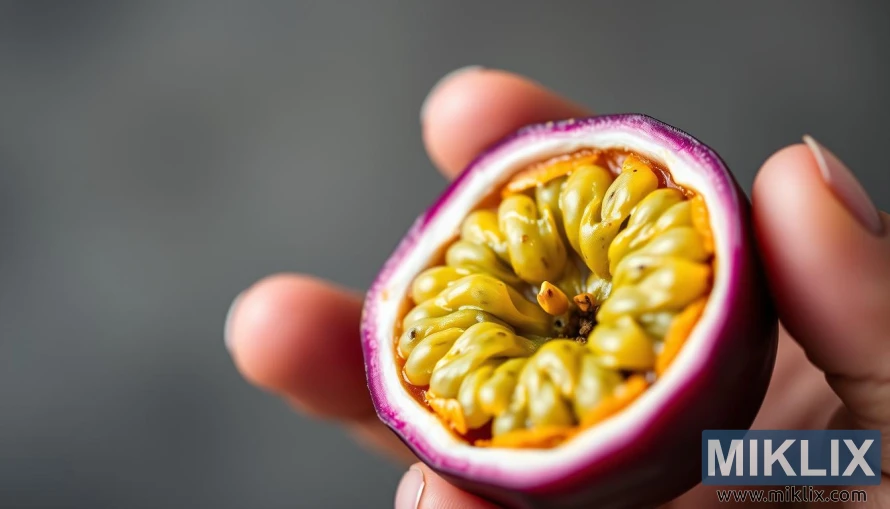Image: Passion fruit health cautions
Published: May 22, 2025 at 8:44:47 AM UTC
Last updated: September 26, 2025 at 7:11:00 AM UTC
Close-up of a passion fruit with seedy interior held in hand, symbolizing possible digestive issues and allergies linked to excessive consumption.
In this striking close-up photograph, the viewer’s attention is immediately drawn to the intricate details of a freshly opened passion fruit, its vibrant purple skin framing a luminous, almost otherworldly interior. The outer rind, smooth and richly colored, has been sliced cleanly to reveal a cross-section that juxtaposes the toughness of the exterior with the delicate, jewel-like vibrancy of the pulp within. At the center, a tangle of golden-yellow sacs filled with glossy seeds glisten with natural moisture, their translucent quality catching the light in a way that makes them appear almost alive. The seeds, dark and oval, sit suspended in this gelatinous pulp, hinting at the tangy-sweet burst of flavor that passion fruit lovers so eagerly anticipate. The effect is at once beautiful and complex, as the fruit’s interior radiates both vitality and an almost cautionary allure.
The fruit is carefully held between two fingers, the human element introducing a tactile dimension that emphasizes scale and fragility. The smooth pads of the fingertips contrast with the fruit’s rugged rind and the slick, fleshy pulp, reminding the viewer that the act of consuming passion fruit is not only about taste but also about touch and experience. The fingers hold it delicately, as though aware of the richness and potential risks contained within. For all its alluring qualities, passion fruit can also present challenges when consumed in excess, ranging from digestive discomfort due to its high fiber and seed content to potential allergic reactions in sensitive individuals. This interplay between allure and caution is subtly reinforced by the framing of the image, in which the fruit dominates the foreground, while the hand adds a layer of intimacy and human connection.
The background fades into a blurred, muted palette of grays and soft neutrals, creating a deliberate contrast that ensures the passion fruit remains the focal point. This shallow depth of field heightens the fruit’s vibrancy, while the subdued tones behind it lend the composition a sense of restraint and seriousness. There is an underlying atmosphere of quiet unease here: the tilted angle of the fruit, the muted backdrop, and the intensity of the close-up shot all conspire to suggest that this image is not just celebrating beauty but also carrying a subtle warning. It reminds us that even nature’s most radiant gifts require balance, mindfulness, and respect when brought into the body.
The lighting in this photograph is natural and soft, carefully directed to highlight the glossy surfaces of both the fruit’s rind and pulp without overwhelming them. Highlights shimmer across the sacs of pulp, emphasizing their plump juiciness, while shadows gather gently in the crevices between seeds, lending depth and dimensionality. This balance of light and shadow reflects the duality of the fruit itself: a source of nourishment, antioxidants, and vitamins on one hand, but also a potential irritant or trigger for sensitivities on the other.
Ultimately, the image is a nuanced exploration of passion fruit’s dual nature. It celebrates the fruit’s seductive beauty—the way its deep purple shell hides a vibrant golden core bursting with flavor—while also acknowledging the complexities of its consumption. The composition draws the viewer in with its tactile immediacy and rich coloration, yet leaves them with an awareness of moderation and respect for the body’s responses. More than just a study of fruit, this photograph becomes a meditation on balance, illustrating that what is most captivating in nature often carries with it both pleasure and caution.
The image is related to: The Power of Passion Fruit: A Superfood for Mind and Body

